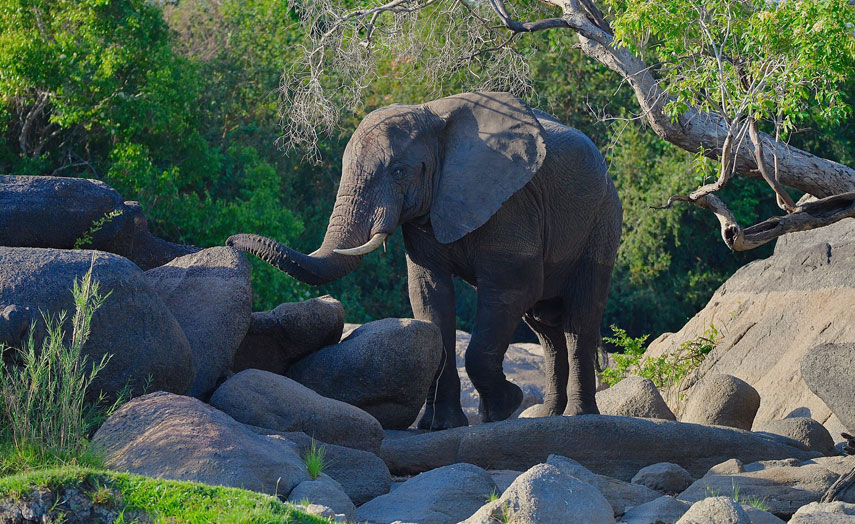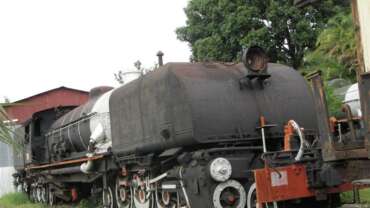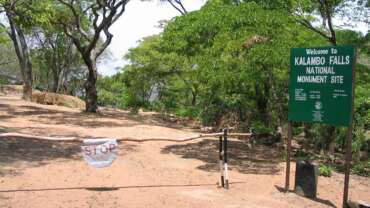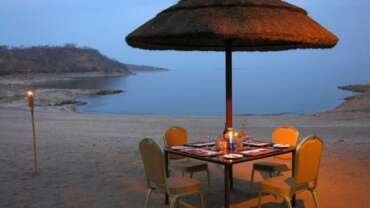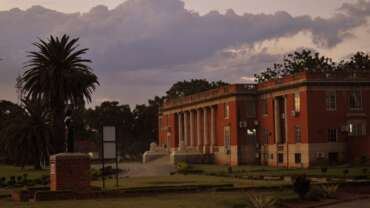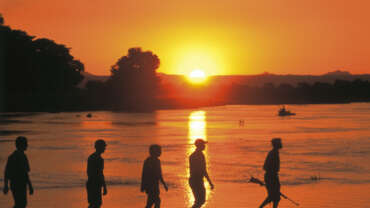National Parks in Zambia
About 30% of Zambia’s 752 614 square kilometers is reserved for wildlife. There are 20 national parks and 34 game management areas in the country. South Luangwa, Kafue and Lower Zambezi rank among the finest game parks in the world.
Luambe, and Lukusuzi Liuwa Plain, West Lunga, Sioma Ngwezi, and Nyika Plateau have substantial wildlife but are still undeveloped. Mosi-oa-Tunya, near Victoria Falls, is regarded as a Zoological park as it has a well managed population of antelope, elephants, giraffe and rhino, but does not have any predators.
Isangano, Lavushi Manda, Lusenga Plain, and Mweru Wantipa have never had management or facilities and have little wildlife but are still worth a visit by intrepid explorers and birdlovers. The newest park to be proclaimed is Lusaka National Park, just outside the capital, which opened to the public in June 2015.
In approximate order of importance in terms of wildlife resources, the 9 main functioning parks, all with access and accommodation are:
POPULAR PARKS
KAFUE NATIONAL PARK
Found in the centre of western Zambia, Kafue National Park is the oldest and largest of Zambia’s national parks. It covers a massive 22,400 km2. First established as a National Park in the 1950’s by the legendary Norman Carr, Kafue is one of the largest national parks in the whole of Africa. Despite its size and prominent location only two hours drive from Livingstone, it remains little-known and largely unexplored with vast tracts of its virgin bush still untouched. Thanks to its size and variety of habitat types the Kafue holds a fantastic diversity of wildlife.
KASANKA NATIONAL PARK
This peaceful sanctuary, situated on the south western edge of the Lake Bangweulu basin, is one of Zambia’s smallest national parks. It’s 450 km2 however, are so well endowed with rivers, lakes, wetlands, forests, lagoons, meadows and dambos that it supports a uniquely wide range of animals and abundant birds and fish. Do not expect to see large herds of animals round every corner, but it is surely one of the most picturesque parks in Zambia with superb birdlife.
LOCHINVAR NATIONAL PARK
Lochinvar, although not abundant in the larger mammals, is nonetheless a park of exceptional beauty and outstanding birding opportunities with over 420 recorded species in its 428 square kilometers. The Park is situated on the southern edge of the Kafue Flats, a wide floodplain of the Kafue River between Itezhi tezhi dam in the west and Kafue Gorge in the east. The area extends for 33kms from the Kafue River in the north to low wooded hills in the south. It includes the large, shallow Chunga Lagoon which fluctuates considerably in size with variations in river levels. The varying vegetation makes it an interesting park to visit with floodplains, woodlands and termitaria. It is particularly well known for the large herds of Kafue lechwe, unique to the Kafue flats. Other antelope are the blue wildebeest, kudu, oribi and buffalo. Waterbirds are especially abundant.
LOWER ZAMBEZI NATIONAL PARK
This Park is still relatively undeveloped, it’s beauty lying in it’s wilderness state. The diversity of animals is not as wide as the other big parks, but the opportunities to get close to game wandering in and out of the Zambezi channels are spectacular. The Park lies opposite the famous Mana Pools Reserve in Zimbabwe, so the whole area on both sides of the Zambezi River is a massive wildlife sanctuary. The River’s edge is overhung with a thick riverine fringe, including ebony and fig trees. Further inland is a floodplain fringed with mopane forest and interspersed with winterthorn trees and huge acacias. The hills which form the backdrop to the Park are covered in broadleaf woodland.
LIUWA PLAIN
This remote park in the far west is pristine wilderness, which, to the ardent bush-lover, is its biggest attraction, and the rewards are great indeed. The game is spread out across the plains and takes some driving around to find, but to come upon a vast herd of blue wildebeest, a prowling wild dog, or a pride of dozing lions in this forgotten piece of Africa is especially fitting because of its completely natural and uncommercialised state.
MOSI OA TUNYA NATIONAL PARK
Bordered between Livingstone town, farm land and the Zambezi River, lies the wildlife area of Mosi-oa-Tunya National Park – Zambia’s smallest National Park. This small reserve was established in 1972 with the idea of having representative wildlife species from Zambia. The park extends from the Batoka Gorge and continues for about 12km along the Zambezi River, above Victoria Falls. Livingstone itself borders on several ancient wildlife migration routes and river crossing points, some of which are still frequented by elephants. A few of these fall within the Mosi-oa-Tunya National Park, where wildlife can be found throughout the year, but elephants especially, during the drier months.
NORTH LUANGWA NATIONAL PARK
This remote tract of land, covering 4636 square kilometres, offers one of the finest wilderness experiences in Zambia, if not Africa itself. It is not open to the public and there are no permanent lodges there. Access is with one of the few safari operators granted permission to conduct walking safaris. The beauty of visiting this Park is the truly remarkable opportunities to experience Africa as it was. It is wild and untouched and you are simply an unobtrusive witness to its natural beauty and drama. Although declared a wilderness area, the North Park, was not open to anyone other than Game Department rangers for more than thirty years. In 1984, Major John Harvey and his wife Lorna sought permission to conduct walking safaris in the area and for many years were the only operators in this remote wilderness.
NSUMBU NATIONAL PARK
Lying on the southern shores of Lake Tanganyika in the Northern most tip of Zambia, Nsumbu National Park covers an area of just over 2000 square kilometers. It includes 100kms of some of the most pristine shores of this vast Lake. Its beauty ranges from sandy beaches, vertical cliffs, rocky coves and natural bays to the rugged hills and deep valleys of the interior. The Lufubu River winds its way through the Park and pours into Lake Tanganyika. The western boundary of Nsumbu National Park, or Sumbu as it is called locally, is buffered by Tondwa Game Management Area, an IUCN Category VIII Multiple Use Management Area of 54,000 ha. The much larger Kaputa Game Management Area (360,000 ha) is also contiguous with the National Park to the north-west and south-west, and therefore the National Park completely surrounds Tondwa. Nsumbu National Park and the two Game Management Areas thus form important parts of a network of Protected Areas in Zambia.
SIOMA NGWEZI NATIONAL PARK
Sioma Ngwezi National Park is mainly covered by Kalahari woodland. It is the third largest Park in Zambia covering a total area of more than 5000 km2. The Park has been heavily poached, but the situation is improving and wildlife is recovering. As an example elephants are returning to the Park, seen at the southeast border where elephants have re-established an old migration route, now very visible with several tracks in a corridor extending over more than one kilometer. In the Park most wild game associated with the African bush may be encountered although up to now in fairly low numbers. According to wildlife scouts from the Zambian Wildlife Authority (ZAWA) the Park holds a huge variety of game species such as elephant, lion, leopard, hyena, cheetah, wild dog, giraffe, eland, sable, roan, tsessebe, zebra, impala, kudu, duiker, buffalo, hippo, crocodile and sitatunga as well as a great number of birds.
SOUTH LUANGWA NATIONAL PARK
Experts have dubbed South Luangwa to be one of the greatest wildlife sanctuaries in the world, and not without reason. The concentration of animals around the Luangwa River, and its oxbow lagoons, is among the most intense in Africa. The Luangwa River is the most intact major river system in Africa and is the life-blood of this 9059 km2 Park. The Park hosts a wide variety of wildlife, birds and vegetation. The now famous ‘walking safari’ originated in this Park and is still one of the finest ways to experience Africa’s pristine wilderness first-hand. The changing seasons add to the Park’s richness, ranging from; dry, bare bushveld in the winter, to a lush, green wonderland in the summer months. There are 60 different animal species and over 400 different bird species in South Luangwa National Park. The only notable exception is the rhino, sadly poached to extinction.
SMALLER PARKS
BLUE LAGOON NATIONAL PARK
This Park is an undiscovered gem. The vast plains are spectacular in the dry season and transform completely from a dry grass flatland to a watery wonderland in the wet season, as the flats fill with water and the migratory birds arrive from far and wide. Until recently, this park was not open to the public as it fell under the preserve of the Defence Ministry. It was established more than 40 years ago by the Critchleys, a retired colonel from the British Army and his wife Erica – an environmentally oriented farming family who then sold it to the National Parks Department. Their farmhouse still exists which is now the Park reception. A little further on are two old chalets and two new chalets available for accommodation.
ISANGANO NATIONAL PARK
Situated in the Northern province of Zambia – the Isangano National Park is a small park close to the Bangweulu swamps. The park offers a different kind of appeal to many of Zambia’s other parks. It’s composed of mainly low-lying floodplains and flat well-watered grassland. The western side forms part of the Bangweulu wetlands which comes along with seasonal flooding and a profusion of birdlife. The area was declared a national park and protected reserve in 1972, but unfortunately, the park went into decline many years ago due to the consequences of a lack of funds, infrastructure, support and management – resulting in little wildlife and infrastructure in the park. However, since July 2007, the Zambian government started to take steps to preserve the wetlands and develop a viable community-friendly wildlife reserve. The opportunity exists to conserve and resuscitate park back to its former status as a fully-fledged National Park.
LAVUSHI MANDA NATIONAL PARK
Lavushi Manda is a picturesque park with rolling hills, rich riparian forest and striking rocky outcrops. Though the park is fairly large at 1,500km2, poaching over the last few decades has grossly reduced the number of animals found within the park’s boundaries and tourist infrastructure and roads are limited at best. However, a new development project that began in 2011 in affiliation with the Kasanka Trust looks to up the anti-poaching drive and improve roads, so it would be worth monitoring the park’s progress in the months and years to come.
LUAMBE NATIONAL PARK
At just 254 km², Luambe is one of Zambia’s smallest national parks. Situated on the eastern bank of the Luangwa it lies in the heart of the Luangwa valley between Lukusuzi, North and South Luangwa national parks. The park was declared in 1938 and is therefore one of the oldest conservation areas in Zambia. The wildlife found in Luambe is similar to that of its larger neighbouring parks and includes all the typical large herbivores, carnivores as well as some less well-known species. However, the animals of Luambe are generally present at lower densities than in the bigger parks with the advantage that Luambe is less crowded than its more famous neighbours.
LUKUSUZI NATIONAL PARK
Located on the eastern escarpment of the Luangwa Valley, between the North and South Luangwa Parks. To date this park has had no development or even management and the status of game is uncertain. There are apparently plans in the pipeline for its privatisation. Check with the tourist board for any new developments. For the curious 4×4 adventurer, it can be approached from the Chipata / Lundazi road, where a poor dirt track to the west traverses the park and connects up with the South Park border road. Not advisable in the wet season. Game scouts do man the gate and may be able to give advice on the condition of the road.
LUSAKA NATIONAL PARK
Lusaka National Park is located roughly 30 kilometres from Zambia’s capital city and opened to the public in June 2015, making it Zambia’s newest and most accessible park. This new and exciting national park is the 20th National Park to be established in Zambia, and only the second national park to be established in a city environment, the first one is the Mosi-Oa-Tunya National Park in Livingstone.
LUSENGA PLAINS NATIONAL PARK
Lusenga Plains National Park is in Luapula province in the North of Zambia. This park has not been operational for many years but it is now being restocked. Impala and zebra have been released , and soon wildebeest . Sabi Sands in SA is working on a project to relocate between 300 and 500 elephant from Sabi to Lusenga Plains and Sumbu NP in May 2009. New network roads are being graded, and funding is being sought for more scouts, firearms, vehicles for anti poaching, bicycles and motorbikes for scouts and possibly a light aircraft for surveys. Lusenga plains is being managed as a trust and is now accessible by road with signposts from Kawambwa.
MWERU WANTIPA NATIONAL PARK
The swampland surrounding Lake Mweru Wantipa in the far northern part of the country is much the same as the swamps of the Bangweulu in its profusion of waterbirds during the rainy season. The lake is surrounded by local fishing villages. It is possible to ask them to take you through the swamps in a dugout for a negotiable fee. Mweru Wantipa National Park, adjacent to the lake, used to harbour vast herds of elephant but poaching however has depleted most of the wildlife although there are still some small herds of buffalo. There are no tourist facilities but it is possible to camp along the lakeshore.
NYIKA NATIONAL PARK
Nyika Plateau is a beautiful, montane, highland area, lying on the Malawian border, at the eastern-most tip of Zambia. The park is actually an extension of the National Park on the Malawian side, which incorporates the part of the plateau that’s crosses the border. Separated into two parts; the Malawian side, and the Zambian side – you can’t go between the two sections without exiting the park and crossing the border before re-entering. Therefore, it is advisable that you contact the Malawian side of the park for their accommodation and rates and entry fees.
WEST LUNGA NATIONAL PARK
West Lunga National Park is one of Zambia’s less visited Parks. It was proclaimed in the 1940s to protect the population of Yellow-backed Duiker, but it has had little official interest over the years and has mainly been used for hunting and fishing by the local communities. Recently the West Lunga Development Trust was set up to help conserve this pristine and relatively sparsely populated area of Zambia. Local communities have been mobilized into Village Action Groups and Community Resource Boards are being set up to sustainably manage the natural resources. A game counting programme has been started and with more controls West Lunga can expect to see a rise in wildlife and visitor numbers in the future.



